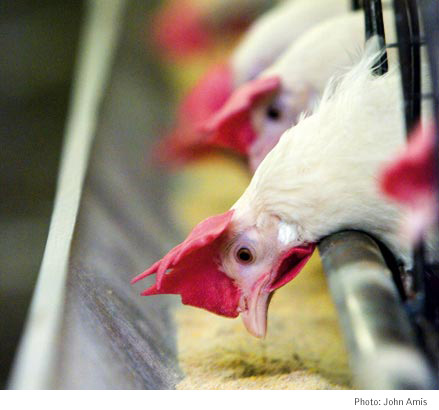


Viruses, Vaccines and the "Unstoppable" Ralph Tripp
by Kelli Whitlock Burton
Intro/ The Making of a Biologist
| Seeking Immunity/ Running Interference
| To Avert the Next Pandemic/ Money Talks

![]()
Facility Supports Research on Disease in Animals and People
To Avert the Next Pandemic
Tripp has always felt a sense of urgency about his work — his colleagues describe him as intense, determined and passionate. These days, his quest to develop an RNAi drug that works against RSV is particularly urgent. If Tripp and colleagues could realize that goal, he believes they could then develop one for combating just about any virus, including the one that now threatens the world with a new pandemic.
Between 1918 and 1919, an outbreak of Spanish flu — one of the largest influenza pandemics in history — killed approximately 50 million people worldwide, according to CDC estimates. To some present-day observers, this long-ago event is ancient history. But Tripp doesn’t see it that way. His work affords him a close view of an emerging viral strain of influenza — H5N1 influenza A virus, also known as avian flu or bird flu — that most experts say could do more damage than the flu of 1918-19.
The first human cases of avian flu were reported in Hong Kong in 1997, where 18 people were hospitalized and six died. In that outbreak, humans contracted the virus from infected poultry. But because this virus is among those known to mutate rapidly, scientists fear the avian flu virus might undergo changes in its molecular structure that would enable it to become transmissible from human to human.
“The bottom line is that we have no immunity to it, we have no vaccine for it and the only treatment option is limited and becoming ineffective,” Tripp said. “The virus is one nucleotide [away] from changing into a pathogenic human virus, and we’re sitting here pretty much naked.”
Tripp and his colleagues began working on strategies to combat H5N1 in 2005, hoping to apply what they’ve learned about RNAi drug development for RSV to this potentially devastating virus. Their idea is to use RNAi to develop a novel anti-viral drug class effective for all influenza virus strains, particularly H5N1, and applicable both to people and potentially to animals infected with avian flu. The synthetic small inhibitory RNA (siRNA) drug would be administered, most likely as an inhalant, entering cells in the lungs where the virus has set up shop. With key viral genes silenced, viruses such as H5N1 would shut down.
Another scenario would be to use the drug as a prophylactic once an influenza outbreak has been detected: People within a certain radius of the outbreak site would be medicated, thereby protecting them from the virus and stopping the outbreak from spreading.
“RNAi is certainly promising for this purpose because you can target components of the virus that traditional pharmaceuticals can’t,” Tompkins said. “It’s also universally applicable — you can target multiple viral or host genes using the same technology.”

In Hong Kong, the site of the first human case of avian flu, people contracted the virus from infected poultry. If the virus mutates so that it can be passed from human to human, however, having a vaccine could be a significant way to stop the spread of disease.
Money Talks
In late spring 2005, Tripp found himself describing these possibilities to members of the House of Representatives’ Energy and Commerce Committee. It was the type of message he relays often these days. Tripp noted that a substantial portion of his time is spent talking to national and state policymakers about the promise of RNAi drug development. This is a necessary step, he believes, in doing translational science, and he’s relieved to see that policymakers are responding — particularly in taking the avian flu threat seriously.
Their interest is welcome, but what Tripp and others working on avian flu vaccines and therapies say they want most is money for ongoing research.
“We have a product that works, but we need to get the funding to help test it in the clinic and produce it on a large scale,” he said. Without government support, scientists may never overcome these obstacles, he added. “Universities, industry, even the usual National Institutes of Health grants don’t provide sufficient resources to push that through.”
If any scientist can convince government, Tripp is the one, said his former mentor, Doherty. He is “extremely dynamic, driven and adventurous in his approach.” In a word, noted Doherty, Tripp is “unstoppable.”
For more information, contact Ralph Tripp at rtripp@vet.uga.edu or access http://www.vet.uga.edu/ID/tripp.html. For more information on the flu, access the CDC’s site at http://www.cdc.gov/flu.
Kelli Whitlock Burton is an award-winning freelance writer and editor who has worked for Scientific American, the Boston Globe and other national media.
Intro/ The Making of a Biologist
| Seeking Immunity/ Running Interference
| To Avert the Next Pandemic/ Money Talks
For comments or for information please e-mail: rcomm@uga.edu
To contact the webmaster please email: ovprweb@uga.edu
![]()